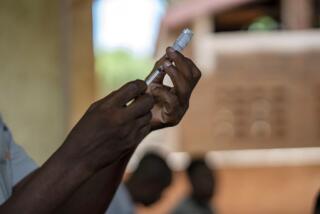Vaccines for Childhood Illnesses on Horizon, but There’s a Catch
- Share via
WASHINGTON — Medical science is on the brink of developing newer and more effective vaccines to prevent the scourges of some childhood diseases, but their cost may be too great for poor nations to bear, a United Nations report warned Wednesday.
The study, released by the World Health Organization and UNICEF, predicted that vaccines would be developed within 15 years for currently unpreventable childhood killers, such as diarrheal diseases, acute respiratory infections and malaria. Also, it said, there would be vast improvements in existing vaccines.
“But there is a catch,” the report said. “The new generation vaccines are expected to be many times more expensive than those in use today. Vaccines are likely to cost not cents, but dollars a dose from now on.”
Moreover, the growing reluctance of wealthier countries to donate money to support vaccine programs in the Third World threatens the lives of millions of children, the report said.
It urged governments and others to donate more money to fund the programs to support vaccines for countries that cannot afford them. Treatment for children who develop preventable illnesses “will cost a lot more, both in money and needless suffering,” than paying for immunizations, the report said.
The report asked manufacturers to consider “tiered pricing” for poorer nations so that they would be charged less.
More than 12 million children die every year around the world, 3 million of them before they are a week old, the report said.
The report hailed successes in the global immunization program, noting that the percentage of children immunized against the most common childhood ailments has grown from 5% in 1974 to 80% today.
Nevertheless, it said that lapses in the current system cause the unnecessary deaths of an estimated 2 million children annually from diseases that could be prevented by immunization.
These occur because current vaccines are not 100% effective and because about 20% of the world’s children each year are not fully immunized during their first year against diphtheria, tetanus, whooping cough, polio, tuberculosis and measles. Many children fail to receive all the required doses of a vaccine.
More to Read
Sign up for Essential California
The most important California stories and recommendations in your inbox every morning.
You may occasionally receive promotional content from the Los Angeles Times.













